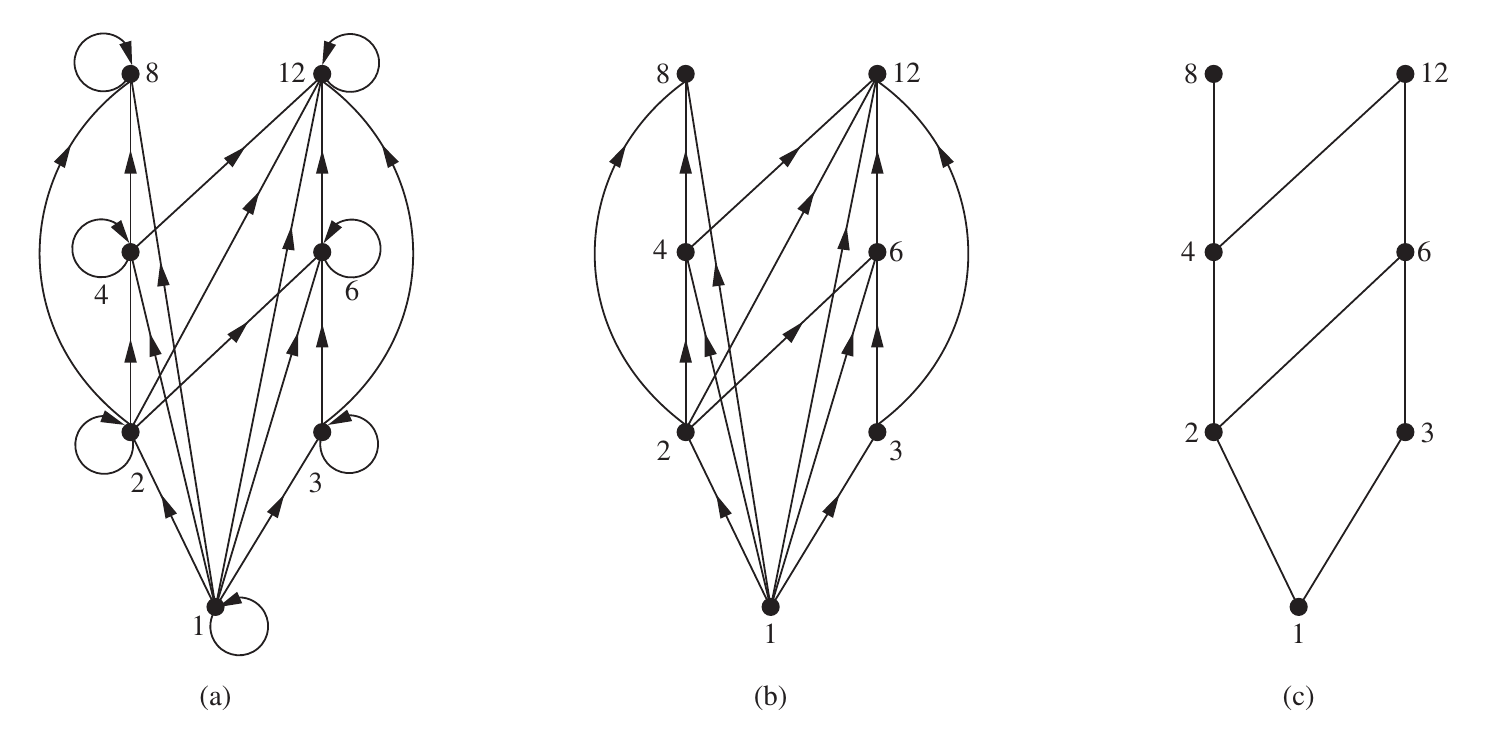Definition
A relation on a set is called a partial ordering or partial order if it is reflexive, antisymmetric and transitive. A set together with a partial ordering is called a partially ordered set, or poset, and is denoted by . Members of are called the elements of the poset.
Example
and are posets
Total-Ordered and Well-Ordered
The elements and of a poset are called comparable if or . When and are elements of such that neither nor , and are called incomparable.
The adjective "partial" is used to describe partial orderings because pairs of elements may be incomparable. When every two elements in the set are comparable, the relation is called a total ordering.
If is a poset and every two elements of are comparable, is called totally ordered or linearly ordered set, and is called a total order or a linear order. A totally ordered set is also called a chain.
Example
is totally ordered, while is not.
is a well-ordered set is its a poset such that is a total ordering and every non-empty subset of has a least element.
The Principle of Well-ordered Induction
Suppose that is a well-ordered set. Then is true for all ,if
- For every , if is true for all with , then is true.
This is a generation of mathematical induction
Note
We do not need a basis step in a proof using the principle of well-ordered induction because if is the least element of a well-ordered set, the inductive step tells us that is true. This follows because there are no elements with , so we know that is true for all with .
Lexicographic Order
The lexicographic ordering on is defined by specifying that if and only if either or both and . Then we obtain a partial ordering by adding equality to the ordering on .
Hasse Diagram
Hasse diagram illustrates the relationships between elements of the poset by depicting them as vertices connected by line segments, which indicate the order relations among them.
- Each element of the poset is represented as a point (or vertex) in the diagram. The points are arranged in such a way that if one element is less than another (), the point for appears lower than that for in the diagram
- A line segment is drawn between two points if one element covers another. An element covers if and there is no element such that . This means that the diagram does not include redundant connections, simplifying the representation
The following figure shows the process to construct the Hasse diagram of

Maximal and Minimal Elements
is maximal in the poset is there is no such that . is minimal in the poset is there is no such that .
Maximal and minimal elements are easy to spot using a Hasse diagram. They are the "top" and "bottom" elements in the diagram.
is the greatest element of the poset if for all . The greatest element is unique when it exists is the least element of the poset if for all . The least element is unique when it exists.
Sometimes it is possible to find an element that is greater than or equal to all the elements in a subset of a poset .
If is an element of such that for all elements , then is called an upper bound of . Likewise, if is an element of such that for all elements , then is called a lower bound of .
The element is called the least upper bound of the subset if is an upper bound that is less than every other upper bound of . Similarly, the element is called the greatest lower bound of if is greater than every other lower bound of .
Lattices
A partially ordered set in which every pair of elements has both a least upper bound and a greatest lower bound is called a lattice.
For example, the poset is a lattice: Let and be two positive integers. The least upper bound and greatest lower bound of these two integers are the least common multiple and the greatest common divisor of these integers, respectively.
Topological Sorting
The goal of topological sorting is to convert the partial order into a total order, where every pair of elements is comparable. This is particularly useful in scenarios like scheduling tasks where certain tasks must precede others.
- Identify Minimal Elements: Begin with the poset and identify minimal elements (elements that have no predecessors).
- Remove and Record: Remove one minimal element from the set and record it in the output list.
- Repeat: Continue this process until all elements have been removed from the poset.
The output will be a linear sequence of elements such that if , then aa appears before bb in the list